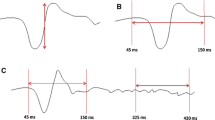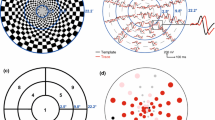Abstract
Purpose To describe a method for monitoring progression of glaucoma using the multifocal visual evoked potential (mfVEP) technique. Methods Eighty-seven patients diagnosed with open-angle glaucoma were divided into two groups. Group I, comprised 43 patients who had a repeat mfVEP test within 50 days (mean 0.9 ± 0.5 months), and group II, 44 patients who had a repeat test after at least 6 months (mean 20.7 ± 9.7 months). Monocular mfVEPs were obtained using a 60-sector pattern reversal dartboard display. Monocular and interocular analyses were performed. Data from the two visits were compared. The total number of abnormal test points with P < 5% within the visual field (total scores) and number of abnormal test points within a cluster (cluster size) were calculated. Data for group I provided a measure of test–retest variability independent of disease progression. Data for group II provided a possible measure of progression. Results The difference in the total scores for group II between visit 1 and visit 2 for the interocular and monocular comparison was significant (P < 0.05) as was the difference in cluster size for the interocular comparison (P < 0.05). Group I did not show a significant change in either total score or cluster size. Conclusion The change in the total score and cluster size over time provides a possible method for assessing progression of glaucoma with the mfVEP technique.






Similar content being viewed by others
References
Zeimer R, Asrani S, Zou S, Quigley H, Jampel H (1998) Quantitative detection of glaucomatous damage at the posterior pole by retinal thickness mapping. A pilot study. Ophthalmology 105:224–231. doi:10.1016/S0161-6420(98)92743-9
Chauhan BC, McCormick TA, Nicolela MT, LeBlanc RP (2001) Optic disc and visual field changes in a prospective longitudinal study of patients with glaucoma: comparison of scanning laser tomography with conventional perimetry and optic disc photography. Arch Ophthalmol 119:1492–1499
Miglior S, Casula M, Guareschi M, Marchetti I, Iester M, Orzalesi N (2001) Clinical ability of Heidelberg retinal tomograph examination to detect glaucomatous visual field changes. Ophthalmology 108:1621–1627. doi:10.1016/S0161-6420(01)00676-5
Boehm MD, Nedrud C, Greenfield DS, Chen PP (2003) Scanning laser polarimetry and detection of progression after optic disc hemorrhage in patients with glaucoma. Arch Ophthalmol 121:189–194
Stein DM, Wollstein G, Schuman JS (2004) Imaging in glaucoma. Ophthalmol Clin North Am 17:33–52. doi:10.1016/S0896-1549(03)00102-0
Kalaboukhova L, Fridhammar V, Lindblom B (2006) Glaucoma follow-up by the Heidelberg Retina Tomograph. Graefes Arch Clin Exp Ophthalmol 244:654–662
Philippin H, Unsoeld A, Maier P, Walter S, Bach M, Funk J (2006) Ten-year results: detection of long-term progressive optic disc changes with confocal laser tomography. Graefes Arch Clin Exp Ophthalmol 244:670–674. doi:10.1007/s00417-005-0094-4
Quigley HA, Addicks EM, Green WR (1982) Optic nerve damage in human glaucoma. III. Quantitative correlation of nerve fiber loss and visual field defect in glaucoma, ischemic neuropathy, papilledema, and toxic neuropathy. Arch Ophthalmol 100:135–146
Quigley HA, Dunkelberger GR, Green WR (1989) Retinal ganglion cell atrophy correlated with automated perimetry in human eyes with glaucoma. Am J Ophthalmol 107:453–464
Quigley HA, Katz J, Derick RJ, Gilbert D, Sommer A (1992) An evaluation of optic disc and nerve fiber layer examinations in monitoring progression of early glaucoma damage. Ophthalmology 99:19–28
Kerrigan-Baumrind LA, Quigley HA, Pease ME, Kerrigan DF, Mitchell RS (2000) Number of ganglion cells in glaucoma eyes compared with threshold visual field tests in the same persons. Invest Ophthalmol Vis Sci 41:741–748
Werner EB, Petrig B, Krupin T, Bishop KI (1989) Variability of automated visual fields in clinically stable glaucoma patients. Invest Ophthalmol Vis Sci 30:1083–1089
Advanced Glaucoma Intervention Study (1994) 2. Visual field test scoring and reliability. Ophthalmology 101:1445–1455
Fitzke FW, Hitchings RA, Poinoosawmy D, McNaught AI, Crabb DP (1996) Analysis of visual field progression in glaucoma. Br J Ophthalmol 80:40–48. doi:10.1136/bjo.80.1.40
Chen CS, Hood DC, Zhang X, Karam EZ, Liebmann JM, Ritch R et al (2003) Repeat reliability of the multifocal visual evoked potential in normal and glaucomatous eyes. J Glaucoma 12:399–408. doi:10.1097/00061198-200310000-00002
Fortune B, Demirel S, Zhang X, Hood DC, Johnson CA (2006) Repeatability of normal multifocal VEP: implications for detecting progression. J Glaucoma 15:131–141. doi:10.1097/00061198-200604000-00010
Klistorner A, Graham SL (2005) Intertest variability of mfVEP amplitude: reducing its effect on the interpretation of sequential tests. Doc Ophthalmol 111:159–167. doi:10.1007/s10633-005-5363-3
Graham SL, Klistorner A, Grigg JR, Billson FA (1999) Objective perimetry in glaucoma: recent advances with multifocal stimuli. Surv Ophthalmol 43(1):199–209. doi:10.1016/S0039-6257(99)00011-9
Hood DC, Zhang X, Greenstein VC, Kangovi S, Odel JG, Liebmann JM et al (2000) An interocular comparison of the multifocal VEP: a possible technique for detecting local damage to the optic nerve. Invest Ophthalmol Vis Sci 41:1580–1587
Klistorner A, Graham SL (2000) Objective perimetry in glaucoma. Ophthalmology 107:2283–2299. doi:10.1016/S0161-6420(00)00367-5
Hood DC, Greenstein VC (2003) Multifocal VEP and ganglion cell damage: applications and limitations for the study of glaucoma. Prog Retin Eye Res 22:201–251. doi:10.1016/S1350-9462(02)00061-7
Graham SL, Klistorner AI, Grigg JR, Billson FA (2000) Objective VEP perimetry in glaucoma: asymmetry analysis to identify early deficits. J Glaucoma 9:10–19
Thienprasiddhi P, Greenstein VC, Chen CS, Liebmann JM, Ritch R, Hood DC (2003) Multifocal visual evoked potential responses in glaucoma patients with unilateral hemifield defects. Am J Ophthalmol 136:34–40. doi:10.1016/S0002-9394(03)00080-1
Hood DC, Thienprasiddhi P, Greenstein VC, Winn BJ, Ohri N, Liebmann JM et al (2004) Detecting early to mild glaucomatous damage: a comparison of the multifocal VEP and automated perimetry. Invest Ophthalmol Vis Sci 45:492–498. doi:10.1167/iovs.03-0602
Graham SL, Klistorner AI, Goldberg I (2005) Clinical application of objective perimetry using multifocal visual evoked potentials in glaucoma practice. Arch Ophthalmol 123:729–739. doi:10.1001/archopht.123.6.729
Hood DC, Zhang X, Hong JE, Chen CS (2002) Quantifying the benefits of additional channels of multifocal VEP recording. Doc Ophthalmol 104:303–320. doi:10.1023/A:1015235617673
Fortune B, Zhang X, Hood DC, Demirel S, Johnson CA (2004) Normative ranges and specificity of the multifocal VEP. Doc Ophthalmol 109:87–100. doi:10.1007/s10633-004-3300-5
Zhang X, Hood DC, Chen CS, Hong JE (2002) A signal-to-noise analysis of multifocal VEP responses: an objective definition for poor records. Doc Ophthalmol 104:287–302. doi:10.1023/A:1015220501743
Hood DC, Zhang X, Winn BJ (2003) Detecting glaucomatous damage with multifocal visual evoked potentials: how can a monocular test work? J Glaucoma 12:3–15. doi:10.1097/00061198-200302000-00002
Bland JM, Altman DG (1986) Statistical methods for assessing agreement between two methods of clinical measurement. Lancet 1:307–310
Spry PG, Johnson CA (2002) Identification of progressive glaucomatous visual field loss. Surv Ophthalmol 47:158–173. doi:10.1016/S0039-6257(01)00299-5
Chauhan BC, Johnson CA (1999) Test–retest variability of frequency-doubling perimetry and conventional perimetry in glaucoma patients and normal subjects. Invest Ophthalmol Vis Sci 40:648–656
Wild JM, Pacey IE, Hancock SA, Cunliffe IA (1999) Between-algorithm, between-individual differences in normal perimetric sensitivity: full threshold, FASTPAC, and SITA. Swedish Interactive Threshold algorithm. Invest Ophthalmol Vis Sci 40:1152–1161
Wild JM, Pacey IE, O’Neill EC, Cunliffe IA (1999) The SITA perimetric threshold algorithms in glaucoma. Invest Ophthalmol Vis Sci 40:1998–2009
Spry PG, Johnson CA, McKendrick AM, Turpin A (2003) Measurement error of visual field tests in glaucoma. Br J Ophthalmol 87:107–112. doi:10.1136/bjo.87.1.107
Goldberg I, Graham SL, Klistorner AI (2002) Multifocal objective perimetry in the detection of glaucomatous field loss. Am J Ophthalmol 133:29–39. doi:10.1016/S0002-9394(01)01294-6
Zhang X, Hood DC (2004) Increasing the sensitivity of the multifocal visual evoked potential (mfVEP) technique: incorporating information from higher order kernels using a principal component analysis method. Doc Ophthalmol 108:211–222. doi:10.1007/s10633-004-5323-3
Balachandran C, Graham SL, Klistorner A, Goldberg I (2006) Comparison of objective diagnostic tests in glaucoma: Heidelberg retinal tomography and multifocal visual evoked potentials. J Glaucoma 15:110–116. doi:10.1097/00061198-200604000-00006
Bjerre A, Grigg JR, Parry NR, Henson DB (2004) Test–retest variability of multifocal visual evoked potential and SITA standard perimetry in glaucoma. Invest Ophthalmol Vis Sci 45:4035–4040. doi:10.1167/iovs.04-0099
Artes PH, Nicolela MT, LeBlanc RP, Chauhan BC (2005) Visual field progression in glaucoma: total versus pattern deviation analyses. Invest Ophthalmol Vis Sci 46:4600–4606. doi:10.1167/iovs.05-0827
Mikelberg FS, Drance SM (1984) The mode of progression of visual field defects in glaucoma. Am J Ophthalmol 98:443–445. doi:10.1016/0002-9394(84)90128-4
Hood DC, Greenstein VC, Odel JG, Zhang X, Ritch R, Liebmann JM et al (2002) Visual field defects and multifocal visual evoked potentials: evidence of a linear relationship. Arch Ophthalmol 120:1672–1681
Acknowledgments
The authors gratefully acknowledge Dr Vorapong Chowchuvech for assistance in statistical analysis. Supported in part by NIH/NEI grant EY02115, the Steven and Shelley Einhorn Research Fund of the New York Glaucoma Research Institute, the Starr Foundation and unrestricted grants from Research to Prevent Blindness to the Department of Ophthalmology, Columbia University, and the Department of Ophthalmology, New York University School of Medicine, New York, NY. The authors had no financial relationship with the organizations that supported this study and instruments that were mentioned in this study.
Author information
Authors and Affiliations
Corresponding author
Rights and permissions
About this article
Cite this article
Wangsupadilok, B., Greenstein, V.C., Kanadani, F.N. et al. A method to detect progression of glaucoma using the multifocal visual evoked potential technique. Doc Ophthalmol 118, 139–150 (2009). https://doi.org/10.1007/s10633-008-9149-2
Received:
Accepted:
Published:
Issue Date:
DOI: https://doi.org/10.1007/s10633-008-9149-2




